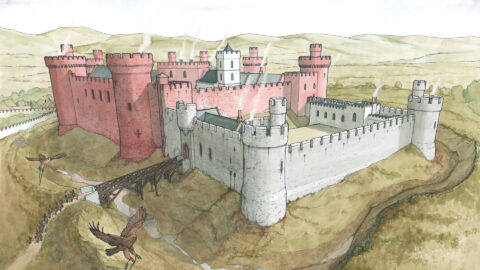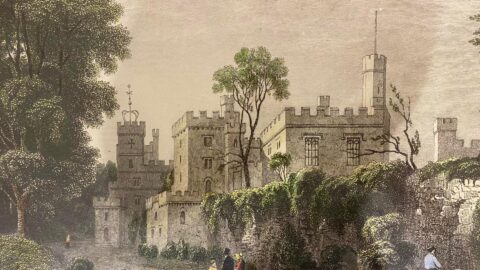13th - 15th Century
RUTHIN CASTLE HISTORY
The first documented castle was created by Dafydd, brother of Prince Llewelyn ap Gruffydd, for King Edward I of England in 1277. Dafydd also had castles at Caergwle and Denbigh.
It was originally known by Welsh name of Castell Coch yn yr Gwernfor or The Red Castle in the Great Marsh. It consisted of a pentagonal upper bailey that was around 350ft long & 250ft wide with the floor level on the inside higher than the ground outside, which then sloped down to the river below. The other side of the castle was protected by a deep & wide dry moat.
In 1282, war flared as a result of the English barons seizing Welsh land, and in Easter 1282, the previously mentioned Dafydd ap Gruffydd of Ruthin Castle, attacked Hawarden Castle, starting the final conflict with the English monarchy that led to the loss of Welsh independence.
That year Dafydd succeeded his brother Llyweln as Prince of Wales, the very last independent ruler of Wales but Edward I enlisted the services of Reginald de Grey, a noted military leader, to quell the rebellion.
De Grey was a descendant of the Norman knight, Anchetil de Greye who accompanied William the Conqueror during the conquest of England. Some suggest that Reginald de Grey had previously been tasked with raising the ‘finest army in the land’ to deal with the followers of the outlaw Robin Hood.
In a strange twist of fate, Dafydd ap Gruffydd was captured & found guilty of high treason by Edward I who had him executed in the cruellest possible fashion including being hung, drawn & quartered, with the quarters dispatched to the four corners of the country & his head ‘spiked atop the Tower of London’. For his services & loyalty to the King, Reginald de Grey was granted the Cantref of Dyffryn Clwyd (Cantref is a mediaeval Welsh land division, particularly important in the administration of Welsh law), which included its stronghold of Ruthin Castle.
The ‘de Grey’ family remained at Ruthin Castle until 1508. They had clung on to their domain through various upsets & throughout the War of the Roses. They were military experts & men of outstanding ability in the affairs of state.
They were valued by both the houses of Lancaster & York but towards the end of the 14th century, Reginald, the 3rd Baron of Ruthin, came into conflict with a neighbour over the right to a piece of land at Croesau (known now as Bryn Eglwys).


The Welsh had been loyal & content during the reign of King Richard II but after he left the throne, fresh disturbances broke out. Both Reginald de Grey & Owain Glyndwr had served Richard well & both were well thought of by Henry IV, but a crisis was looming. Henry IV resumed war with Scotland & to raise an army, he issued writs to all his Barons. The task of passing the said writ to Owain fell upon Reginald, who decided not to give it to him, thus putting Owain in bad favour with the King. Reginald’s plan for gaining Owain’s land was thus put into action whilst Owain presumed that he had been slighted by the King. Soon after this, a minor revolt grew quickly & Owain guessed that it was Reginald behind it and set out to plunder Reginald’s land.
On the 18 September 1400, during the preparation for the great fair on St. Matthews Day (21 September), Owain hit the town of Ruthin in a furious attack. His men looted & burned the town down but were unable to take the castle. It wasn’t until 2 years later at a place called Bryn Saith Marchog, that Owain caught Reginald in an ambush & took him captive & placed a hefty ransom upon his head of 10,000 marks. The terms were very stiff but King Henry VII agreed to them on behalf of the de Grey’s. The de Grey’s never fully recovered from the severe loss inflicted by the heavy ransom.



